CLBE304: Implementing a Cloud Solution in an Enterprise Report
VerifiedAdded on 2023/03/23
|18
|5325
|25
Report
AI Summary
This report delves into the critical application of cloud-based solutions within an enterprise context, specifically focusing on Crown Resorts Limited, a major Australian gaming and entertainment group. It explores the importance of cloud computing, discussing Infrastructure as a Service (IaaS), Platform as a Service (PaaS), and Software as a Service (SaaS) models, along with cloud architectures and technologies. The report examines the technical capabilities and business benefits of virtualization, and the various applications that leverage cloud computing. It addresses requirements during cloud deployment, proposes appropriate cloud computing recommendations, and discusses ethical, governance, maintenance, and security considerations. The implementation strategies for the recommended cloud solutions are also presented, concluding with an overview of the key findings and recommendations for successful cloud adoption within the enterprise. The report aims to provide a comprehensive understanding of cloud implementation challenges and solutions.
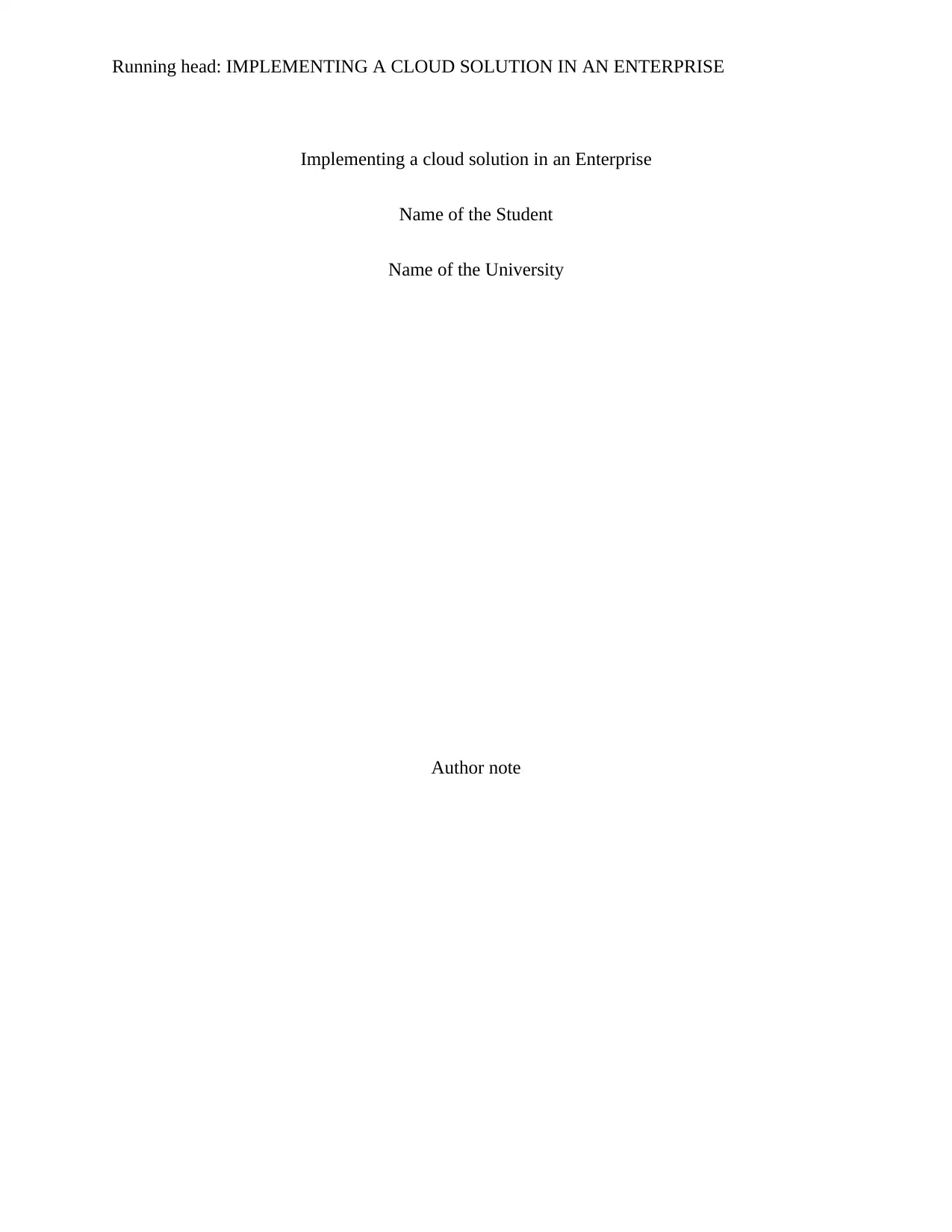
Running head: IMPLEMENTING A CLOUD SOLUTION IN AN ENTERPRISE
Implementing a cloud solution in an Enterprise
Name of the Student
Name of the University
Author note
Implementing a cloud solution in an Enterprise
Name of the Student
Name of the University
Author note
Paraphrase This Document
Need a fresh take? Get an instant paraphrase of this document with our AI Paraphraser
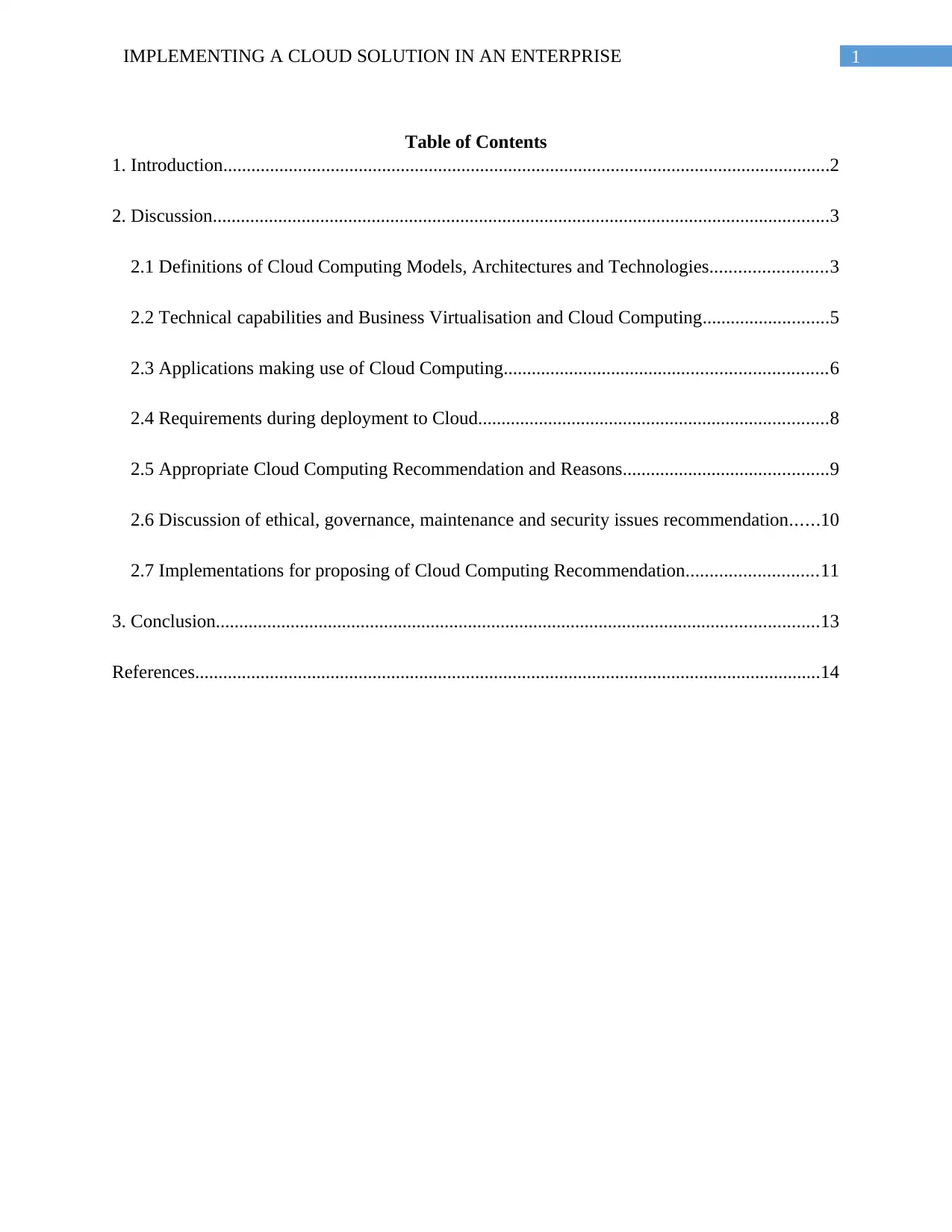
1IMPLEMENTING A CLOUD SOLUTION IN AN ENTERPRISE
Table of Contents
1. Introduction..................................................................................................................................2
2. Discussion....................................................................................................................................3
2.1 Definitions of Cloud Computing Models, Architectures and Technologies.........................3
2.2 Technical capabilities and Business Virtualisation and Cloud Computing...........................5
2.3 Applications making use of Cloud Computing.....................................................................6
2.4 Requirements during deployment to Cloud...........................................................................8
2.5 Appropriate Cloud Computing Recommendation and Reasons............................................9
2.6 Discussion of ethical, governance, maintenance and security issues recommendation......10
2.7 Implementations for proposing of Cloud Computing Recommendation............................11
3. Conclusion.................................................................................................................................13
References......................................................................................................................................14
Table of Contents
1. Introduction..................................................................................................................................2
2. Discussion....................................................................................................................................3
2.1 Definitions of Cloud Computing Models, Architectures and Technologies.........................3
2.2 Technical capabilities and Business Virtualisation and Cloud Computing...........................5
2.3 Applications making use of Cloud Computing.....................................................................6
2.4 Requirements during deployment to Cloud...........................................................................8
2.5 Appropriate Cloud Computing Recommendation and Reasons............................................9
2.6 Discussion of ethical, governance, maintenance and security issues recommendation......10
2.7 Implementations for proposing of Cloud Computing Recommendation............................11
3. Conclusion.................................................................................................................................13
References......................................................................................................................................14
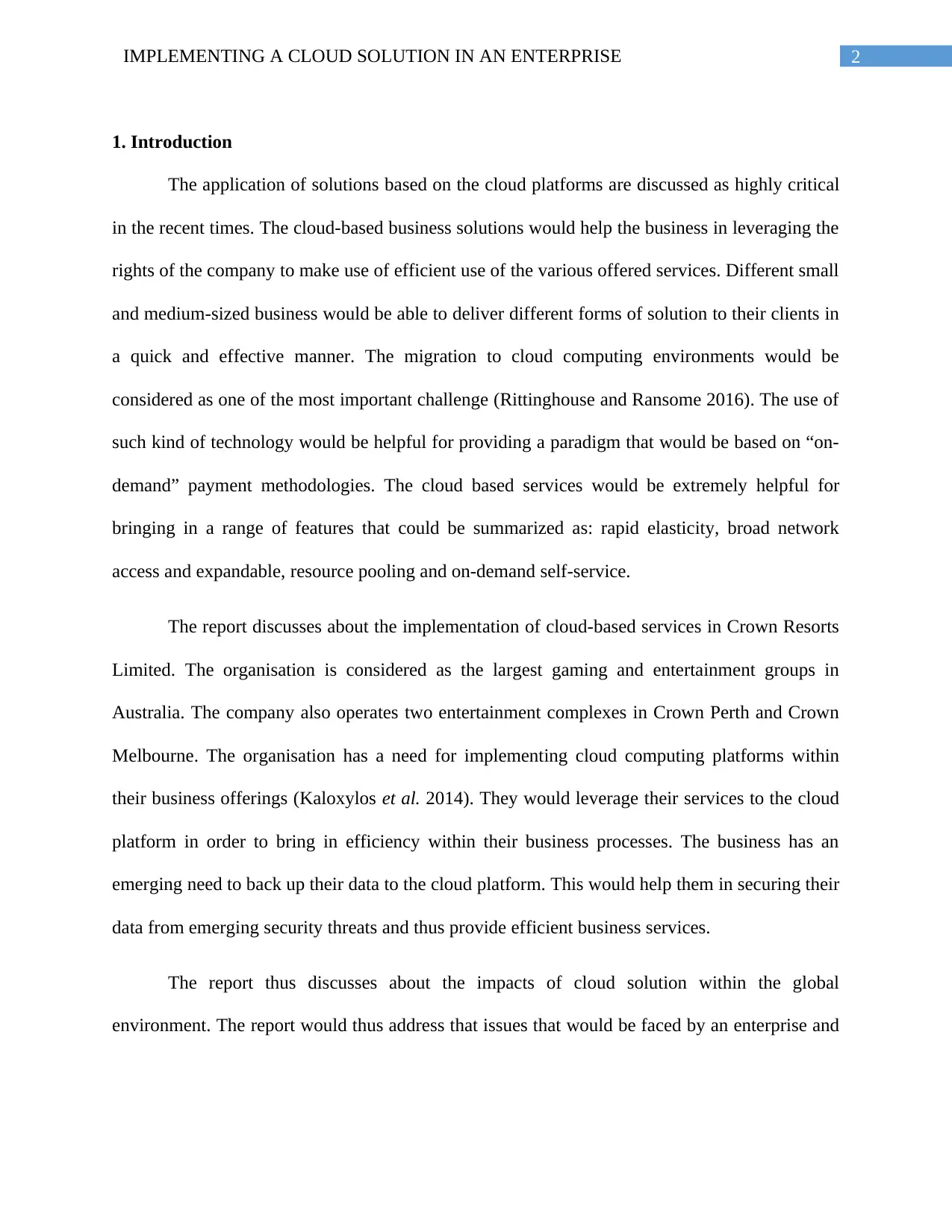
2IMPLEMENTING A CLOUD SOLUTION IN AN ENTERPRISE
1. Introduction
The application of solutions based on the cloud platforms are discussed as highly critical
in the recent times. The cloud-based business solutions would help the business in leveraging the
rights of the company to make use of efficient use of the various offered services. Different small
and medium-sized business would be able to deliver different forms of solution to their clients in
a quick and effective manner. The migration to cloud computing environments would be
considered as one of the most important challenge (Rittinghouse and Ransome 2016). The use of
such kind of technology would be helpful for providing a paradigm that would be based on “on-
demand” payment methodologies. The cloud based services would be extremely helpful for
bringing in a range of features that could be summarized as: rapid elasticity, broad network
access and expandable, resource pooling and on-demand self-service.
The report discusses about the implementation of cloud-based services in Crown Resorts
Limited. The organisation is considered as the largest gaming and entertainment groups in
Australia. The company also operates two entertainment complexes in Crown Perth and Crown
Melbourne. The organisation has a need for implementing cloud computing platforms within
their business offerings (Kaloxylos et al. 2014). They would leverage their services to the cloud
platform in order to bring in efficiency within their business processes. The business has an
emerging need to back up their data to the cloud platform. This would help them in securing their
data from emerging security threats and thus provide efficient business services.
The report thus discusses about the impacts of cloud solution within the global
environment. The report would thus address that issues that would be faced by an enterprise and
1. Introduction
The application of solutions based on the cloud platforms are discussed as highly critical
in the recent times. The cloud-based business solutions would help the business in leveraging the
rights of the company to make use of efficient use of the various offered services. Different small
and medium-sized business would be able to deliver different forms of solution to their clients in
a quick and effective manner. The migration to cloud computing environments would be
considered as one of the most important challenge (Rittinghouse and Ransome 2016). The use of
such kind of technology would be helpful for providing a paradigm that would be based on “on-
demand” payment methodologies. The cloud based services would be extremely helpful for
bringing in a range of features that could be summarized as: rapid elasticity, broad network
access and expandable, resource pooling and on-demand self-service.
The report discusses about the implementation of cloud-based services in Crown Resorts
Limited. The organisation is considered as the largest gaming and entertainment groups in
Australia. The company also operates two entertainment complexes in Crown Perth and Crown
Melbourne. The organisation has a need for implementing cloud computing platforms within
their business offerings (Kaloxylos et al. 2014). They would leverage their services to the cloud
platform in order to bring in efficiency within their business processes. The business has an
emerging need to back up their data to the cloud platform. This would help them in securing their
data from emerging security threats and thus provide efficient business services.
The report thus discusses about the impacts of cloud solution within the global
environment. The report would thus address that issues that would be faced by an enterprise and
⊘ This is a preview!⊘
Do you want full access?
Subscribe today to unlock all pages.

Trusted by 1+ million students worldwide
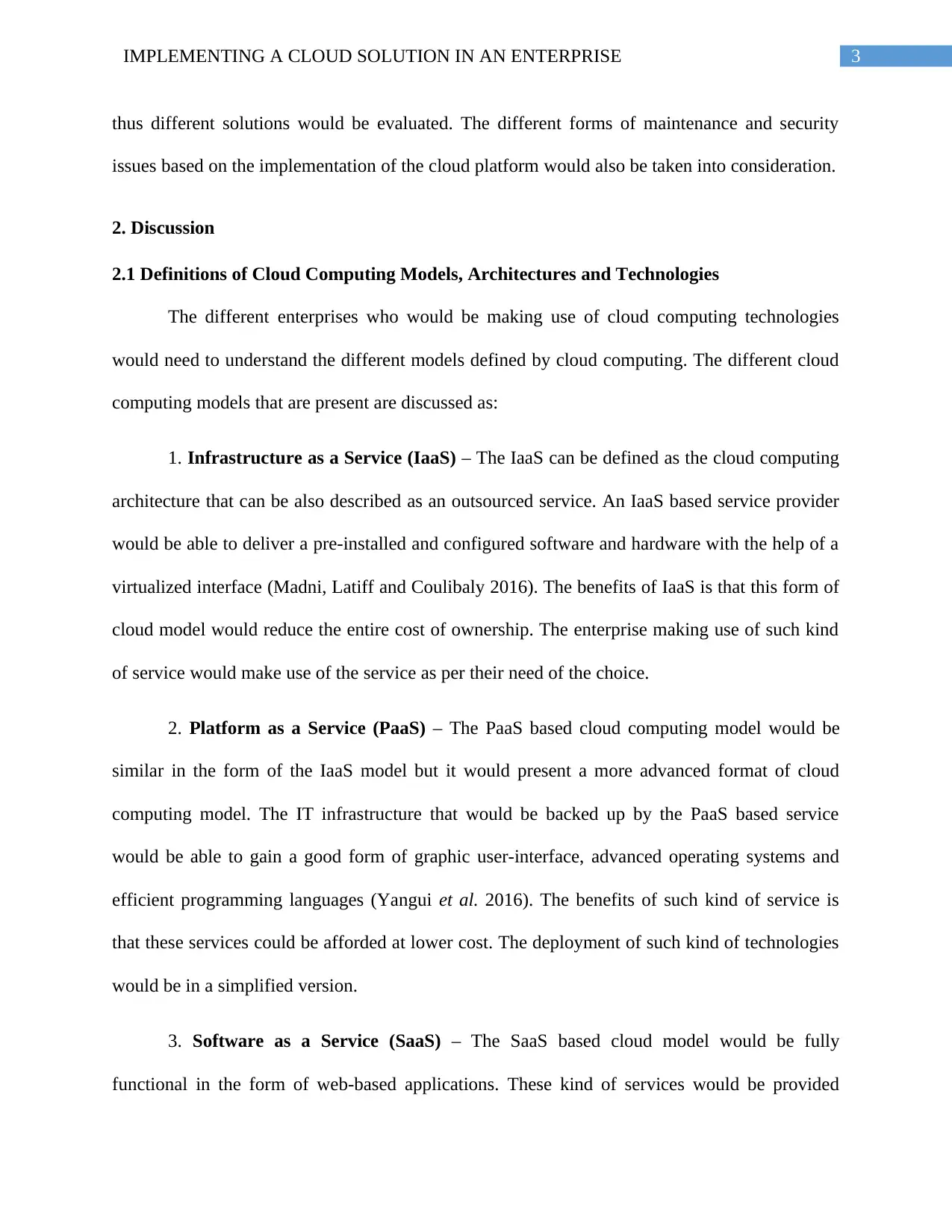
3IMPLEMENTING A CLOUD SOLUTION IN AN ENTERPRISE
thus different solutions would be evaluated. The different forms of maintenance and security
issues based on the implementation of the cloud platform would also be taken into consideration.
2. Discussion
2.1 Definitions of Cloud Computing Models, Architectures and Technologies
The different enterprises who would be making use of cloud computing technologies
would need to understand the different models defined by cloud computing. The different cloud
computing models that are present are discussed as:
1. Infrastructure as a Service (IaaS) – The IaaS can be defined as the cloud computing
architecture that can be also described as an outsourced service. An IaaS based service provider
would be able to deliver a pre-installed and configured software and hardware with the help of a
virtualized interface (Madni, Latiff and Coulibaly 2016). The benefits of IaaS is that this form of
cloud model would reduce the entire cost of ownership. The enterprise making use of such kind
of service would make use of the service as per their need of the choice.
2. Platform as a Service (PaaS) – The PaaS based cloud computing model would be
similar in the form of the IaaS model but it would present a more advanced format of cloud
computing model. The IT infrastructure that would be backed up by the PaaS based service
would be able to gain a good form of graphic user-interface, advanced operating systems and
efficient programming languages (Yangui et al. 2016). The benefits of such kind of service is
that these services could be afforded at lower cost. The deployment of such kind of technologies
would be in a simplified version.
3. Software as a Service (SaaS) – The SaaS based cloud model would be fully
functional in the form of web-based applications. These kind of services would be provided
thus different solutions would be evaluated. The different forms of maintenance and security
issues based on the implementation of the cloud platform would also be taken into consideration.
2. Discussion
2.1 Definitions of Cloud Computing Models, Architectures and Technologies
The different enterprises who would be making use of cloud computing technologies
would need to understand the different models defined by cloud computing. The different cloud
computing models that are present are discussed as:
1. Infrastructure as a Service (IaaS) – The IaaS can be defined as the cloud computing
architecture that can be also described as an outsourced service. An IaaS based service provider
would be able to deliver a pre-installed and configured software and hardware with the help of a
virtualized interface (Madni, Latiff and Coulibaly 2016). The benefits of IaaS is that this form of
cloud model would reduce the entire cost of ownership. The enterprise making use of such kind
of service would make use of the service as per their need of the choice.
2. Platform as a Service (PaaS) – The PaaS based cloud computing model would be
similar in the form of the IaaS model but it would present a more advanced format of cloud
computing model. The IT infrastructure that would be backed up by the PaaS based service
would be able to gain a good form of graphic user-interface, advanced operating systems and
efficient programming languages (Yangui et al. 2016). The benefits of such kind of service is
that these services could be afforded at lower cost. The deployment of such kind of technologies
would be in a simplified version.
3. Software as a Service (SaaS) – The SaaS based cloud model would be fully
functional in the form of web-based applications. These kind of services would be provided
Paraphrase This Document
Need a fresh take? Get an instant paraphrase of this document with our AI Paraphraser
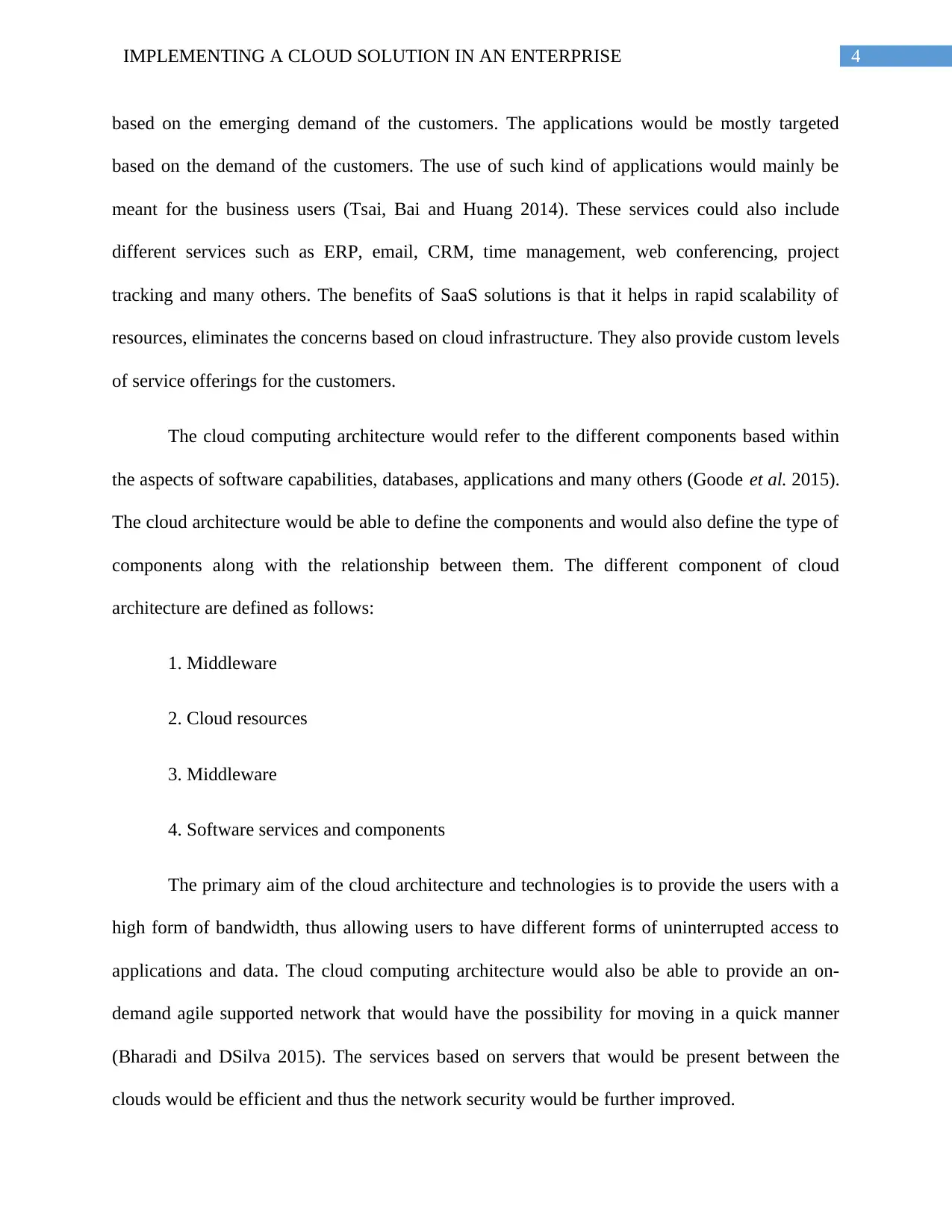
4IMPLEMENTING A CLOUD SOLUTION IN AN ENTERPRISE
based on the emerging demand of the customers. The applications would be mostly targeted
based on the demand of the customers. The use of such kind of applications would mainly be
meant for the business users (Tsai, Bai and Huang 2014). These services could also include
different services such as ERP, email, CRM, time management, web conferencing, project
tracking and many others. The benefits of SaaS solutions is that it helps in rapid scalability of
resources, eliminates the concerns based on cloud infrastructure. They also provide custom levels
of service offerings for the customers.
The cloud computing architecture would refer to the different components based within
the aspects of software capabilities, databases, applications and many others (Goode et al. 2015).
The cloud architecture would be able to define the components and would also define the type of
components along with the relationship between them. The different component of cloud
architecture are defined as follows:
1. Middleware
2. Cloud resources
3. Middleware
4. Software services and components
The primary aim of the cloud architecture and technologies is to provide the users with a
high form of bandwidth, thus allowing users to have different forms of uninterrupted access to
applications and data. The cloud computing architecture would also be able to provide an on-
demand agile supported network that would have the possibility for moving in a quick manner
(Bharadi and DSilva 2015). The services based on servers that would be present between the
clouds would be efficient and thus the network security would be further improved.
based on the emerging demand of the customers. The applications would be mostly targeted
based on the demand of the customers. The use of such kind of applications would mainly be
meant for the business users (Tsai, Bai and Huang 2014). These services could also include
different services such as ERP, email, CRM, time management, web conferencing, project
tracking and many others. The benefits of SaaS solutions is that it helps in rapid scalability of
resources, eliminates the concerns based on cloud infrastructure. They also provide custom levels
of service offerings for the customers.
The cloud computing architecture would refer to the different components based within
the aspects of software capabilities, databases, applications and many others (Goode et al. 2015).
The cloud architecture would be able to define the components and would also define the type of
components along with the relationship between them. The different component of cloud
architecture are defined as follows:
1. Middleware
2. Cloud resources
3. Middleware
4. Software services and components
The primary aim of the cloud architecture and technologies is to provide the users with a
high form of bandwidth, thus allowing users to have different forms of uninterrupted access to
applications and data. The cloud computing architecture would also be able to provide an on-
demand agile supported network that would have the possibility for moving in a quick manner
(Bharadi and DSilva 2015). The services based on servers that would be present between the
clouds would be efficient and thus the network security would be further improved.
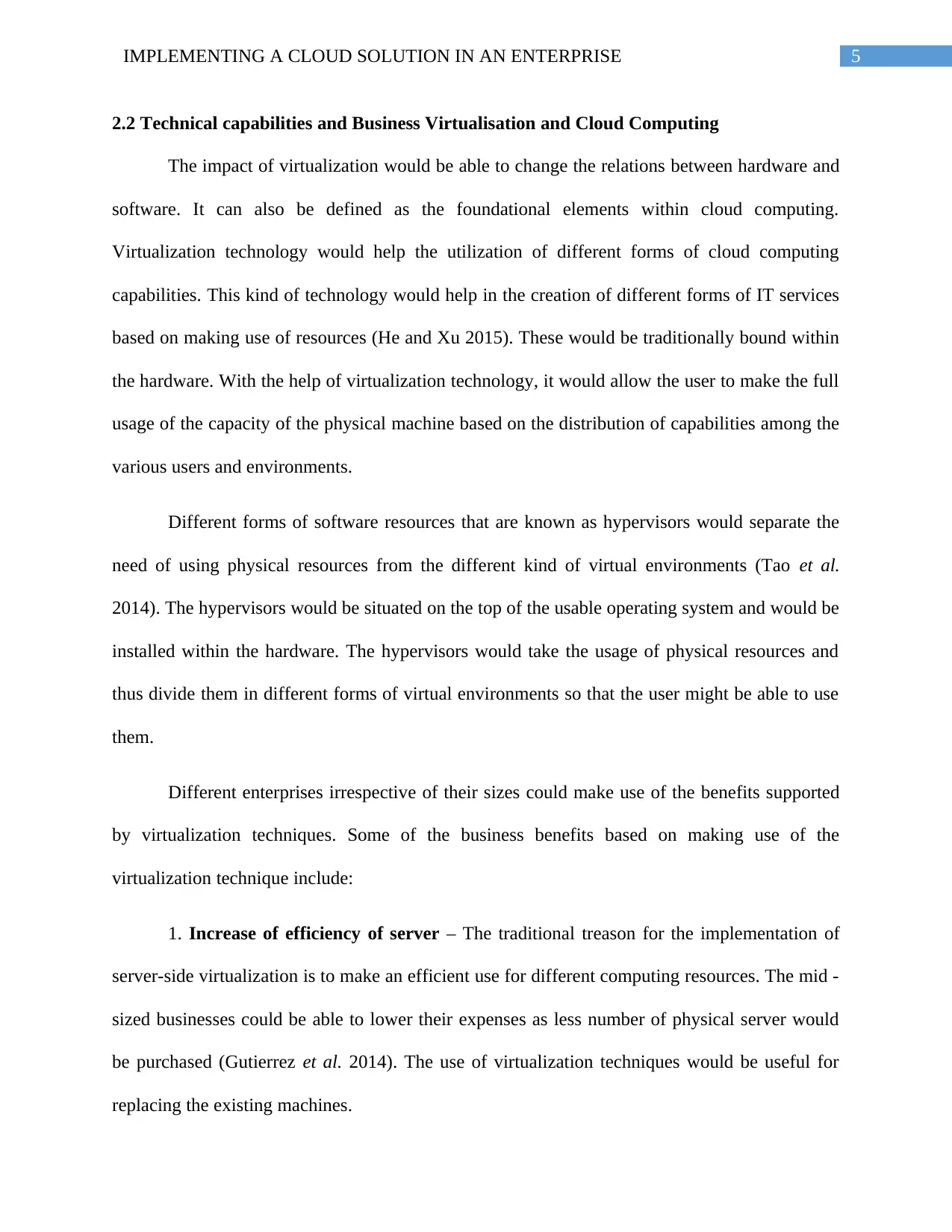
5IMPLEMENTING A CLOUD SOLUTION IN AN ENTERPRISE
2.2 Technical capabilities and Business Virtualisation and Cloud Computing
The impact of virtualization would be able to change the relations between hardware and
software. It can also be defined as the foundational elements within cloud computing.
Virtualization technology would help the utilization of different forms of cloud computing
capabilities. This kind of technology would help in the creation of different forms of IT services
based on making use of resources (He and Xu 2015). These would be traditionally bound within
the hardware. With the help of virtualization technology, it would allow the user to make the full
usage of the capacity of the physical machine based on the distribution of capabilities among the
various users and environments.
Different forms of software resources that are known as hypervisors would separate the
need of using physical resources from the different kind of virtual environments (Tao et al.
2014). The hypervisors would be situated on the top of the usable operating system and would be
installed within the hardware. The hypervisors would take the usage of physical resources and
thus divide them in different forms of virtual environments so that the user might be able to use
them.
Different enterprises irrespective of their sizes could make use of the benefits supported
by virtualization techniques. Some of the business benefits based on making use of the
virtualization technique include:
1. Increase of efficiency of server – The traditional treason for the implementation of
server-side virtualization is to make an efficient use for different computing resources. The mid -
sized businesses could be able to lower their expenses as less number of physical server would
be purchased (Gutierrez et al. 2014). The use of virtualization techniques would be useful for
replacing the existing machines.
2.2 Technical capabilities and Business Virtualisation and Cloud Computing
The impact of virtualization would be able to change the relations between hardware and
software. It can also be defined as the foundational elements within cloud computing.
Virtualization technology would help the utilization of different forms of cloud computing
capabilities. This kind of technology would help in the creation of different forms of IT services
based on making use of resources (He and Xu 2015). These would be traditionally bound within
the hardware. With the help of virtualization technology, it would allow the user to make the full
usage of the capacity of the physical machine based on the distribution of capabilities among the
various users and environments.
Different forms of software resources that are known as hypervisors would separate the
need of using physical resources from the different kind of virtual environments (Tao et al.
2014). The hypervisors would be situated on the top of the usable operating system and would be
installed within the hardware. The hypervisors would take the usage of physical resources and
thus divide them in different forms of virtual environments so that the user might be able to use
them.
Different enterprises irrespective of their sizes could make use of the benefits supported
by virtualization techniques. Some of the business benefits based on making use of the
virtualization technique include:
1. Increase of efficiency of server – The traditional treason for the implementation of
server-side virtualization is to make an efficient use for different computing resources. The mid -
sized businesses could be able to lower their expenses as less number of physical server would
be purchased (Gutierrez et al. 2014). The use of virtualization techniques would be useful for
replacing the existing machines.
⊘ This is a preview!⊘
Do you want full access?
Subscribe today to unlock all pages.

Trusted by 1+ million students worldwide
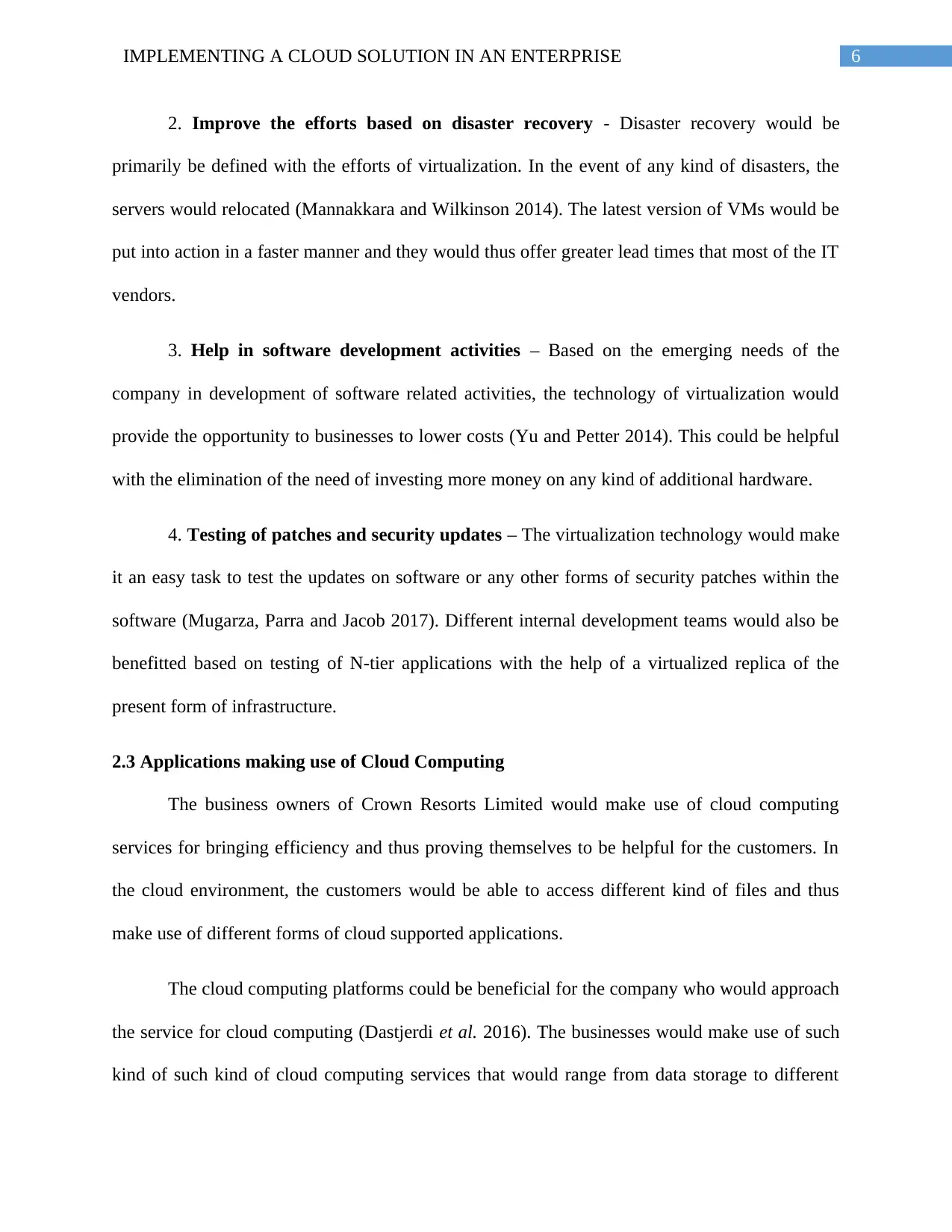
6IMPLEMENTING A CLOUD SOLUTION IN AN ENTERPRISE
2. Improve the efforts based on disaster recovery - Disaster recovery would be
primarily be defined with the efforts of virtualization. In the event of any kind of disasters, the
servers would relocated (Mannakkara and Wilkinson 2014). The latest version of VMs would be
put into action in a faster manner and they would thus offer greater lead times that most of the IT
vendors.
3. Help in software development activities – Based on the emerging needs of the
company in development of software related activities, the technology of virtualization would
provide the opportunity to businesses to lower costs (Yu and Petter 2014). This could be helpful
with the elimination of the need of investing more money on any kind of additional hardware.
4. Testing of patches and security updates – The virtualization technology would make
it an easy task to test the updates on software or any other forms of security patches within the
software (Mugarza, Parra and Jacob 2017). Different internal development teams would also be
benefitted based on testing of N-tier applications with the help of a virtualized replica of the
present form of infrastructure.
2.3 Applications making use of Cloud Computing
The business owners of Crown Resorts Limited would make use of cloud computing
services for bringing efficiency and thus proving themselves to be helpful for the customers. In
the cloud environment, the customers would be able to access different kind of files and thus
make use of different forms of cloud supported applications.
The cloud computing platforms could be beneficial for the company who would approach
the service for cloud computing (Dastjerdi et al. 2016). The businesses would make use of such
kind of such kind of cloud computing services that would range from data storage to different
2. Improve the efforts based on disaster recovery - Disaster recovery would be
primarily be defined with the efforts of virtualization. In the event of any kind of disasters, the
servers would relocated (Mannakkara and Wilkinson 2014). The latest version of VMs would be
put into action in a faster manner and they would thus offer greater lead times that most of the IT
vendors.
3. Help in software development activities – Based on the emerging needs of the
company in development of software related activities, the technology of virtualization would
provide the opportunity to businesses to lower costs (Yu and Petter 2014). This could be helpful
with the elimination of the need of investing more money on any kind of additional hardware.
4. Testing of patches and security updates – The virtualization technology would make
it an easy task to test the updates on software or any other forms of security patches within the
software (Mugarza, Parra and Jacob 2017). Different internal development teams would also be
benefitted based on testing of N-tier applications with the help of a virtualized replica of the
present form of infrastructure.
2.3 Applications making use of Cloud Computing
The business owners of Crown Resorts Limited would make use of cloud computing
services for bringing efficiency and thus proving themselves to be helpful for the customers. In
the cloud environment, the customers would be able to access different kind of files and thus
make use of different forms of cloud supported applications.
The cloud computing platforms could be beneficial for the company who would approach
the service for cloud computing (Dastjerdi et al. 2016). The businesses would make use of such
kind of such kind of cloud computing services that would range from data storage to different
Paraphrase This Document
Need a fresh take? Get an instant paraphrase of this document with our AI Paraphraser
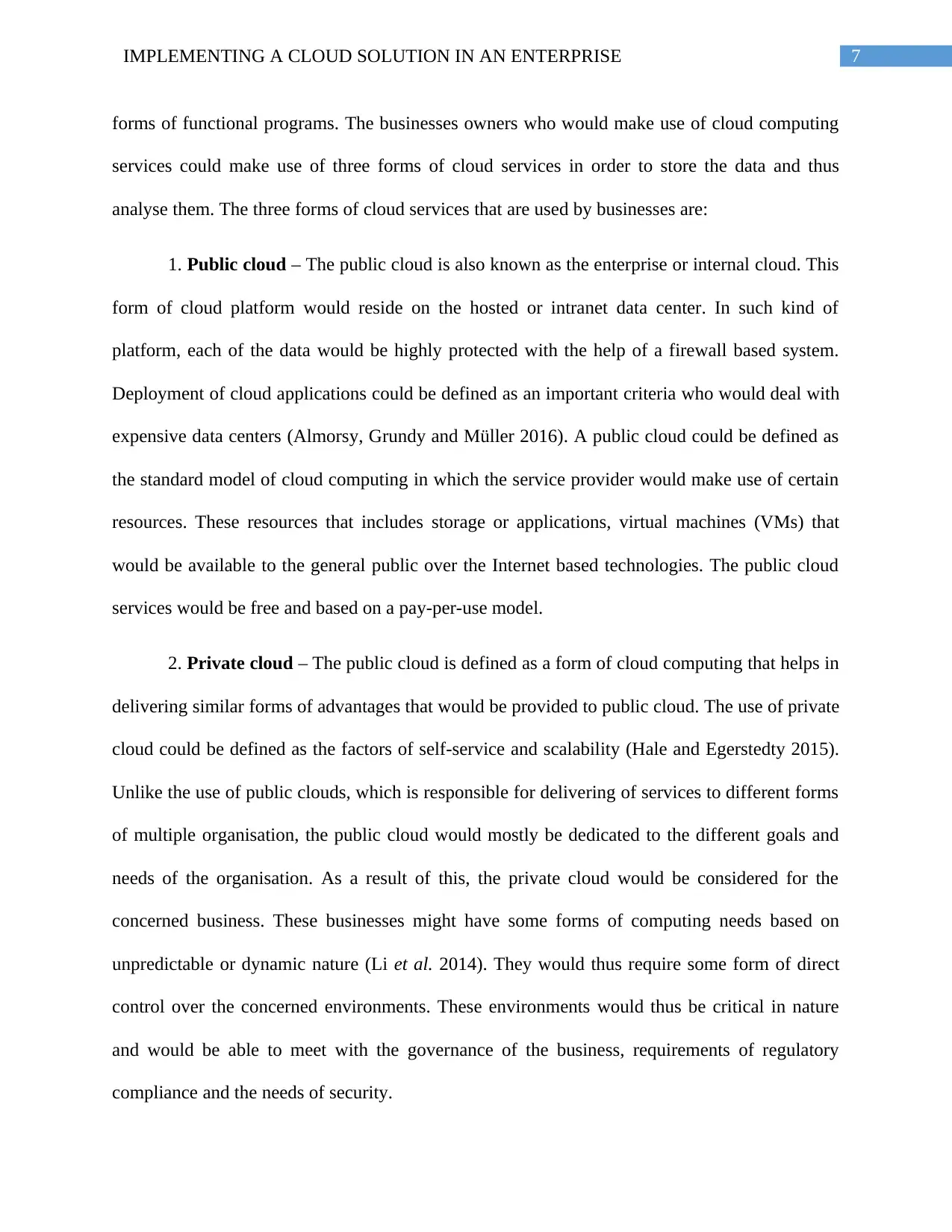
7IMPLEMENTING A CLOUD SOLUTION IN AN ENTERPRISE
forms of functional programs. The businesses owners who would make use of cloud computing
services could make use of three forms of cloud services in order to store the data and thus
analyse them. The three forms of cloud services that are used by businesses are:
1. Public cloud – The public cloud is also known as the enterprise or internal cloud. This
form of cloud platform would reside on the hosted or intranet data center. In such kind of
platform, each of the data would be highly protected with the help of a firewall based system.
Deployment of cloud applications could be defined as an important criteria who would deal with
expensive data centers (Almorsy, Grundy and Müller 2016). A public cloud could be defined as
the standard model of cloud computing in which the service provider would make use of certain
resources. These resources that includes storage or applications, virtual machines (VMs) that
would be available to the general public over the Internet based technologies. The public cloud
services would be free and based on a pay-per-use model.
2. Private cloud – The public cloud is defined as a form of cloud computing that helps in
delivering similar forms of advantages that would be provided to public cloud. The use of private
cloud could be defined as the factors of self-service and scalability (Hale and Egerstedty 2015).
Unlike the use of public clouds, which is responsible for delivering of services to different forms
of multiple organisation, the public cloud would mostly be dedicated to the different goals and
needs of the organisation. As a result of this, the private cloud would be considered for the
concerned business. These businesses might have some forms of computing needs based on
unpredictable or dynamic nature (Li et al. 2014). They would thus require some form of direct
control over the concerned environments. These environments would thus be critical in nature
and would be able to meet with the governance of the business, requirements of regulatory
compliance and the needs of security.
forms of functional programs. The businesses owners who would make use of cloud computing
services could make use of three forms of cloud services in order to store the data and thus
analyse them. The three forms of cloud services that are used by businesses are:
1. Public cloud – The public cloud is also known as the enterprise or internal cloud. This
form of cloud platform would reside on the hosted or intranet data center. In such kind of
platform, each of the data would be highly protected with the help of a firewall based system.
Deployment of cloud applications could be defined as an important criteria who would deal with
expensive data centers (Almorsy, Grundy and Müller 2016). A public cloud could be defined as
the standard model of cloud computing in which the service provider would make use of certain
resources. These resources that includes storage or applications, virtual machines (VMs) that
would be available to the general public over the Internet based technologies. The public cloud
services would be free and based on a pay-per-use model.
2. Private cloud – The public cloud is defined as a form of cloud computing that helps in
delivering similar forms of advantages that would be provided to public cloud. The use of private
cloud could be defined as the factors of self-service and scalability (Hale and Egerstedty 2015).
Unlike the use of public clouds, which is responsible for delivering of services to different forms
of multiple organisation, the public cloud would mostly be dedicated to the different goals and
needs of the organisation. As a result of this, the private cloud would be considered for the
concerned business. These businesses might have some forms of computing needs based on
unpredictable or dynamic nature (Li et al. 2014). They would thus require some form of direct
control over the concerned environments. These environments would thus be critical in nature
and would be able to meet with the governance of the business, requirements of regulatory
compliance and the needs of security.
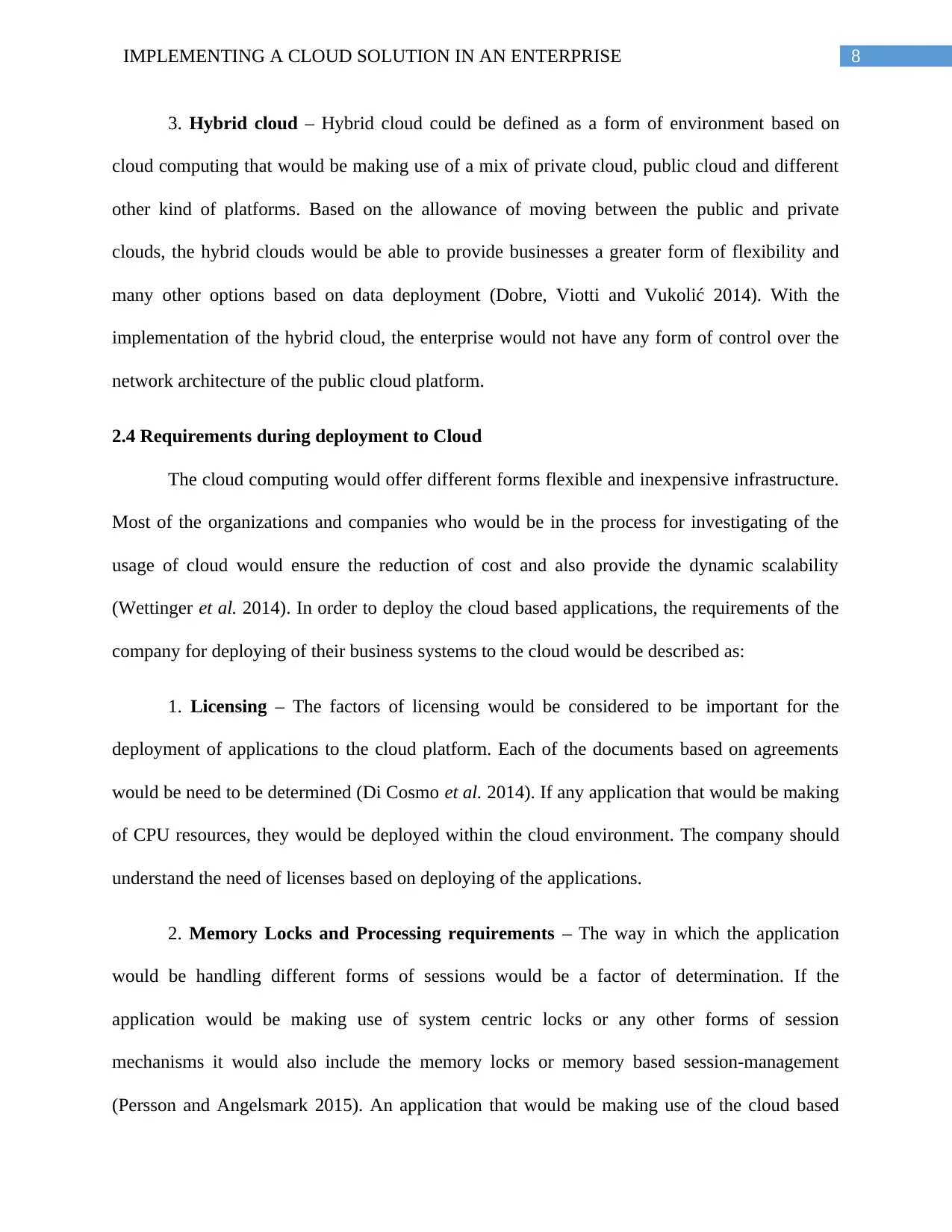
8IMPLEMENTING A CLOUD SOLUTION IN AN ENTERPRISE
3. Hybrid cloud – Hybrid cloud could be defined as a form of environment based on
cloud computing that would be making use of a mix of private cloud, public cloud and different
other kind of platforms. Based on the allowance of moving between the public and private
clouds, the hybrid clouds would be able to provide businesses a greater form of flexibility and
many other options based on data deployment (Dobre, Viotti and Vukolić 2014). With the
implementation of the hybrid cloud, the enterprise would not have any form of control over the
network architecture of the public cloud platform.
2.4 Requirements during deployment to Cloud
The cloud computing would offer different forms flexible and inexpensive infrastructure.
Most of the organizations and companies who would be in the process for investigating of the
usage of cloud would ensure the reduction of cost and also provide the dynamic scalability
(Wettinger et al. 2014). In order to deploy the cloud based applications, the requirements of the
company for deploying of their business systems to the cloud would be described as:
1. Licensing – The factors of licensing would be considered to be important for the
deployment of applications to the cloud platform. Each of the documents based on agreements
would be need to be determined (Di Cosmo et al. 2014). If any application that would be making
of CPU resources, they would be deployed within the cloud environment. The company should
understand the need of licenses based on deploying of the applications.
2. Memory Locks and Processing requirements – The way in which the application
would be handling different forms of sessions would be a factor of determination. If the
application would be making use of system centric locks or any other forms of session
mechanisms it would also include the memory locks or memory based session-management
(Persson and Angelsmark 2015). An application that would be making use of the cloud based
3. Hybrid cloud – Hybrid cloud could be defined as a form of environment based on
cloud computing that would be making use of a mix of private cloud, public cloud and different
other kind of platforms. Based on the allowance of moving between the public and private
clouds, the hybrid clouds would be able to provide businesses a greater form of flexibility and
many other options based on data deployment (Dobre, Viotti and Vukolić 2014). With the
implementation of the hybrid cloud, the enterprise would not have any form of control over the
network architecture of the public cloud platform.
2.4 Requirements during deployment to Cloud
The cloud computing would offer different forms flexible and inexpensive infrastructure.
Most of the organizations and companies who would be in the process for investigating of the
usage of cloud would ensure the reduction of cost and also provide the dynamic scalability
(Wettinger et al. 2014). In order to deploy the cloud based applications, the requirements of the
company for deploying of their business systems to the cloud would be described as:
1. Licensing – The factors of licensing would be considered to be important for the
deployment of applications to the cloud platform. Each of the documents based on agreements
would be need to be determined (Di Cosmo et al. 2014). If any application that would be making
of CPU resources, they would be deployed within the cloud environment. The company should
understand the need of licenses based on deploying of the applications.
2. Memory Locks and Processing requirements – The way in which the application
would be handling different forms of sessions would be a factor of determination. If the
application would be making use of system centric locks or any other forms of session
mechanisms it would also include the memory locks or memory based session-management
(Persson and Angelsmark 2015). An application that would be making use of the cloud based
⊘ This is a preview!⊘
Do you want full access?
Subscribe today to unlock all pages.

Trusted by 1+ million students worldwide
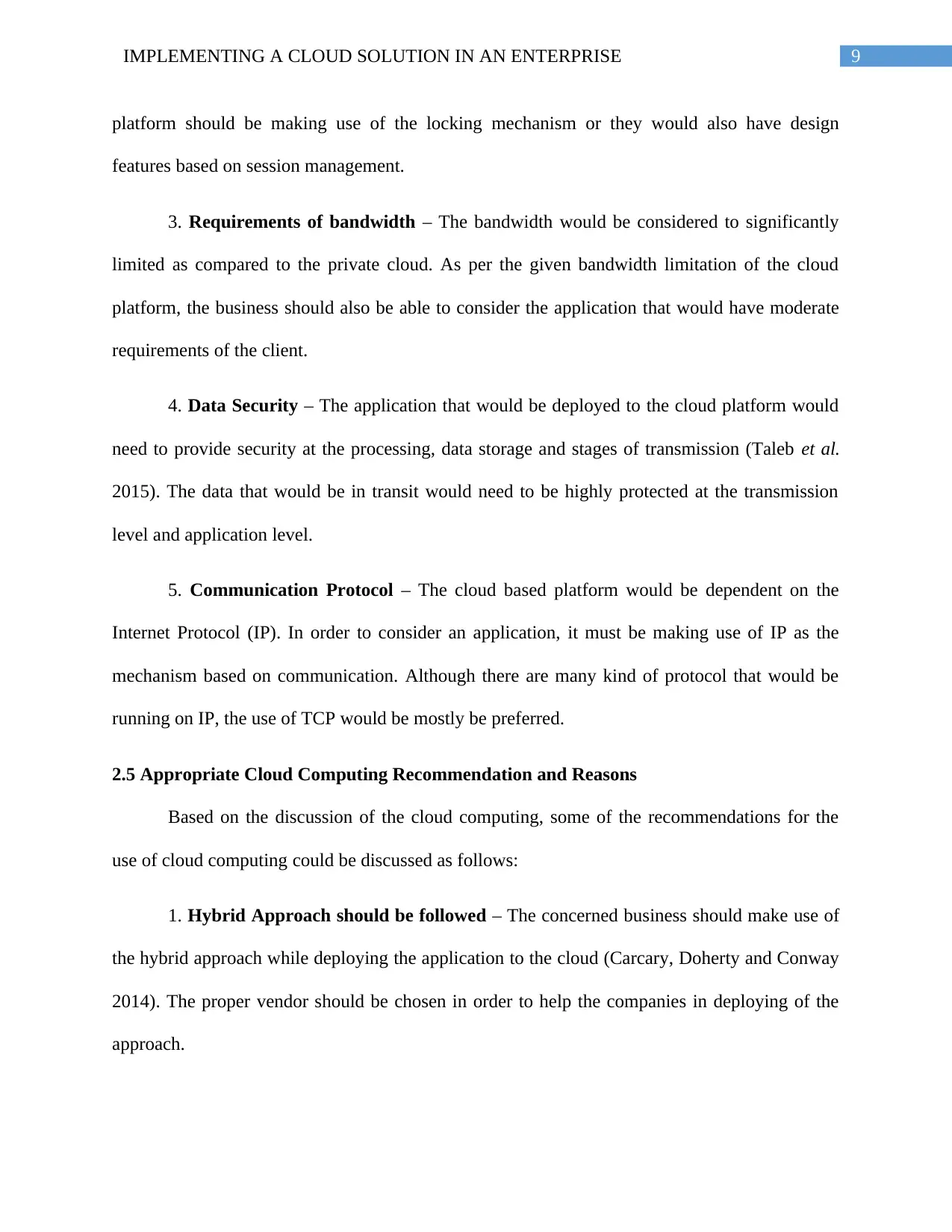
9IMPLEMENTING A CLOUD SOLUTION IN AN ENTERPRISE
platform should be making use of the locking mechanism or they would also have design
features based on session management.
3. Requirements of bandwidth – The bandwidth would be considered to significantly
limited as compared to the private cloud. As per the given bandwidth limitation of the cloud
platform, the business should also be able to consider the application that would have moderate
requirements of the client.
4. Data Security – The application that would be deployed to the cloud platform would
need to provide security at the processing, data storage and stages of transmission (Taleb et al.
2015). The data that would be in transit would need to be highly protected at the transmission
level and application level.
5. Communication Protocol – The cloud based platform would be dependent on the
Internet Protocol (IP). In order to consider an application, it must be making use of IP as the
mechanism based on communication. Although there are many kind of protocol that would be
running on IP, the use of TCP would be mostly be preferred.
2.5 Appropriate Cloud Computing Recommendation and Reasons
Based on the discussion of the cloud computing, some of the recommendations for the
use of cloud computing could be discussed as follows:
1. Hybrid Approach should be followed – The concerned business should make use of
the hybrid approach while deploying the application to the cloud (Carcary, Doherty and Conway
2014). The proper vendor should be chosen in order to help the companies in deploying of the
approach.
platform should be making use of the locking mechanism or they would also have design
features based on session management.
3. Requirements of bandwidth – The bandwidth would be considered to significantly
limited as compared to the private cloud. As per the given bandwidth limitation of the cloud
platform, the business should also be able to consider the application that would have moderate
requirements of the client.
4. Data Security – The application that would be deployed to the cloud platform would
need to provide security at the processing, data storage and stages of transmission (Taleb et al.
2015). The data that would be in transit would need to be highly protected at the transmission
level and application level.
5. Communication Protocol – The cloud based platform would be dependent on the
Internet Protocol (IP). In order to consider an application, it must be making use of IP as the
mechanism based on communication. Although there are many kind of protocol that would be
running on IP, the use of TCP would be mostly be preferred.
2.5 Appropriate Cloud Computing Recommendation and Reasons
Based on the discussion of the cloud computing, some of the recommendations for the
use of cloud computing could be discussed as follows:
1. Hybrid Approach should be followed – The concerned business should make use of
the hybrid approach while deploying the application to the cloud (Carcary, Doherty and Conway
2014). The proper vendor should be chosen in order to help the companies in deploying of the
approach.
Paraphrase This Document
Need a fresh take? Get an instant paraphrase of this document with our AI Paraphraser
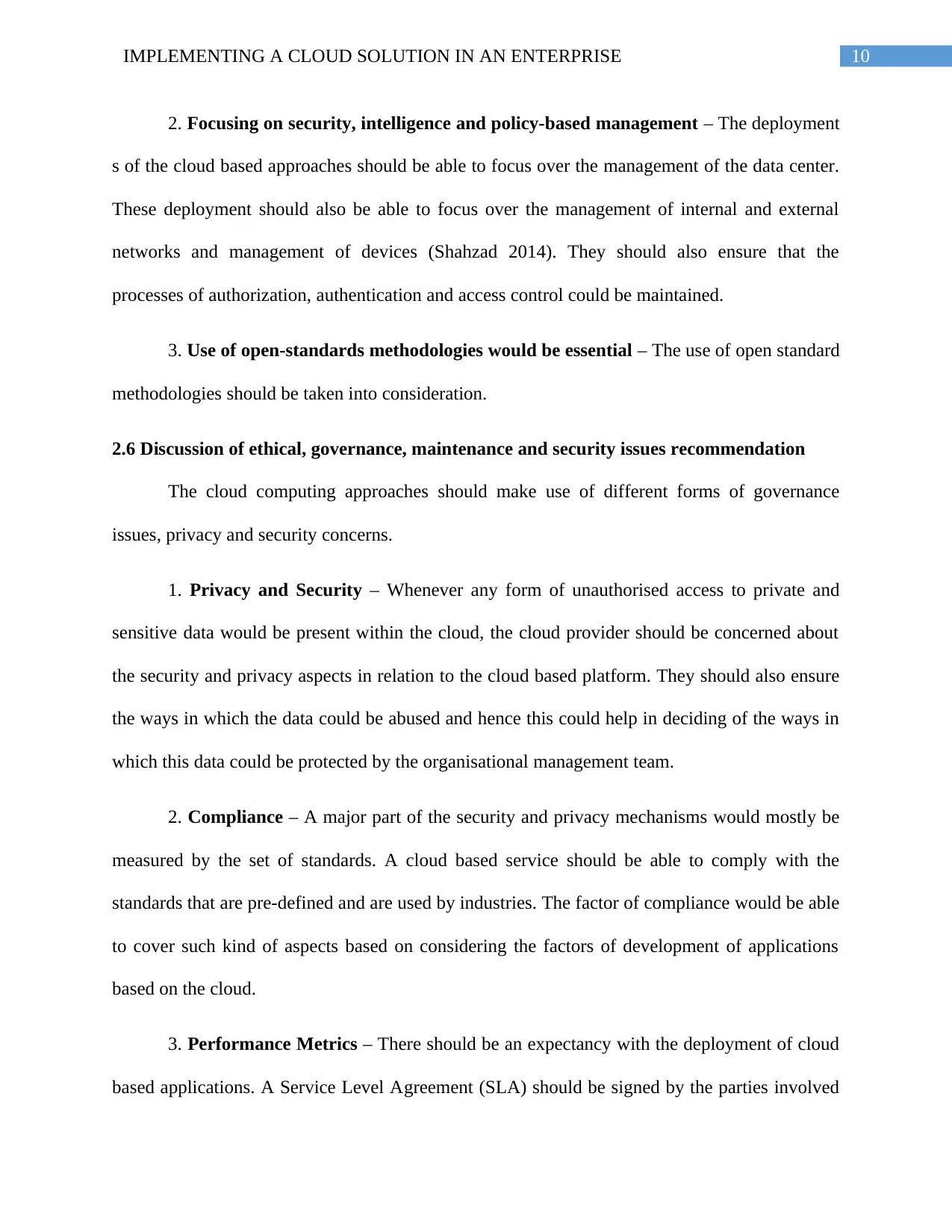
10IMPLEMENTING A CLOUD SOLUTION IN AN ENTERPRISE
2. Focusing on security, intelligence and policy-based management – The deployment
s of the cloud based approaches should be able to focus over the management of the data center.
These deployment should also be able to focus over the management of internal and external
networks and management of devices (Shahzad 2014). They should also ensure that the
processes of authorization, authentication and access control could be maintained.
3. Use of open-standards methodologies would be essential – The use of open standard
methodologies should be taken into consideration.
2.6 Discussion of ethical, governance, maintenance and security issues recommendation
The cloud computing approaches should make use of different forms of governance
issues, privacy and security concerns.
1. Privacy and Security – Whenever any form of unauthorised access to private and
sensitive data would be present within the cloud, the cloud provider should be concerned about
the security and privacy aspects in relation to the cloud based platform. They should also ensure
the ways in which the data could be abused and hence this could help in deciding of the ways in
which this data could be protected by the organisational management team.
2. Compliance – A major part of the security and privacy mechanisms would mostly be
measured by the set of standards. A cloud based service should be able to comply with the
standards that are pre-defined and are used by industries. The factor of compliance would be able
to cover such kind of aspects based on considering the factors of development of applications
based on the cloud.
3. Performance Metrics – There should be an expectancy with the deployment of cloud
based applications. A Service Level Agreement (SLA) should be signed by the parties involved
2. Focusing on security, intelligence and policy-based management – The deployment
s of the cloud based approaches should be able to focus over the management of the data center.
These deployment should also be able to focus over the management of internal and external
networks and management of devices (Shahzad 2014). They should also ensure that the
processes of authorization, authentication and access control could be maintained.
3. Use of open-standards methodologies would be essential – The use of open standard
methodologies should be taken into consideration.
2.6 Discussion of ethical, governance, maintenance and security issues recommendation
The cloud computing approaches should make use of different forms of governance
issues, privacy and security concerns.
1. Privacy and Security – Whenever any form of unauthorised access to private and
sensitive data would be present within the cloud, the cloud provider should be concerned about
the security and privacy aspects in relation to the cloud based platform. They should also ensure
the ways in which the data could be abused and hence this could help in deciding of the ways in
which this data could be protected by the organisational management team.
2. Compliance – A major part of the security and privacy mechanisms would mostly be
measured by the set of standards. A cloud based service should be able to comply with the
standards that are pre-defined and are used by industries. The factor of compliance would be able
to cover such kind of aspects based on considering the factors of development of applications
based on the cloud.
3. Performance Metrics – There should be an expectancy with the deployment of cloud
based applications. A Service Level Agreement (SLA) should be signed by the parties involved
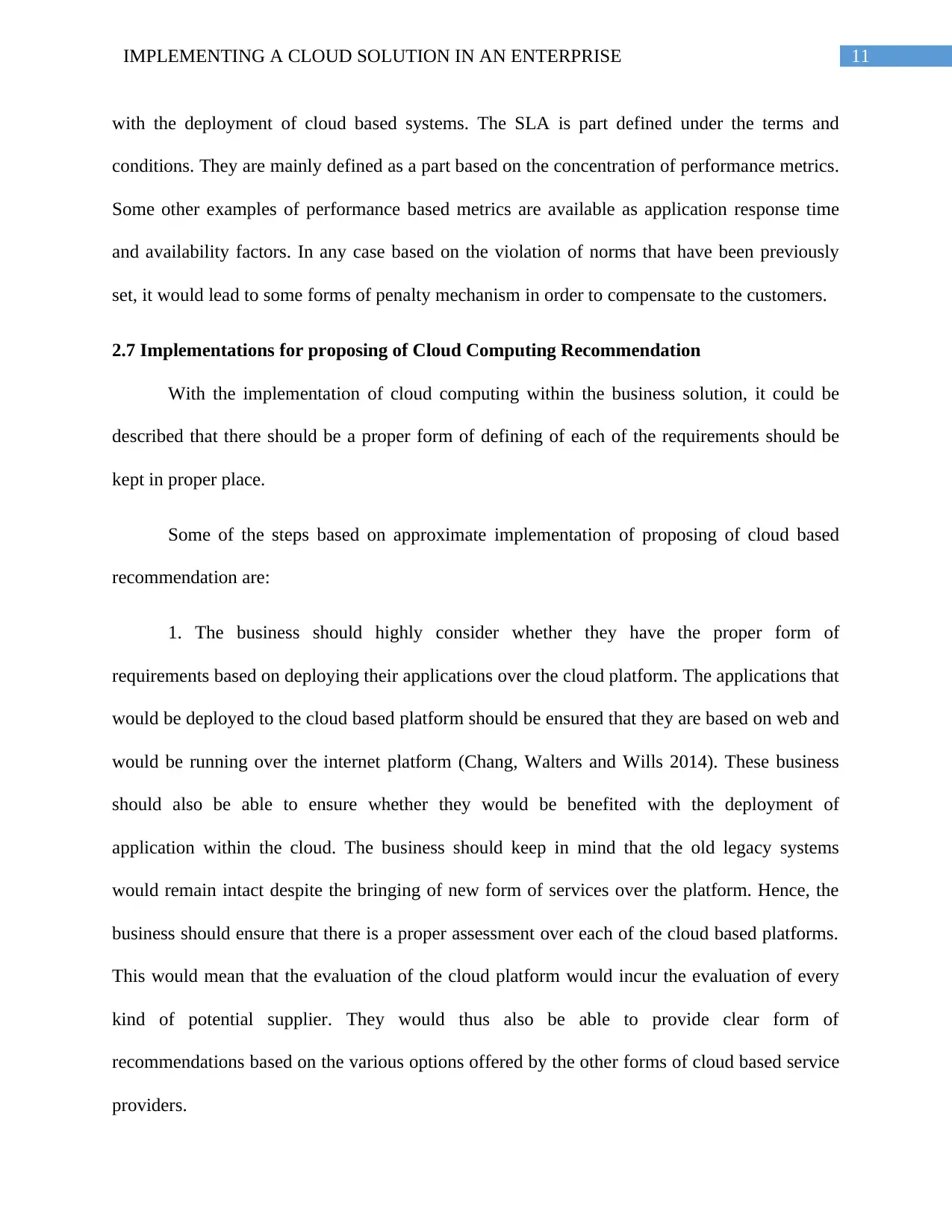
11IMPLEMENTING A CLOUD SOLUTION IN AN ENTERPRISE
with the deployment of cloud based systems. The SLA is part defined under the terms and
conditions. They are mainly defined as a part based on the concentration of performance metrics.
Some other examples of performance based metrics are available as application response time
and availability factors. In any case based on the violation of norms that have been previously
set, it would lead to some forms of penalty mechanism in order to compensate to the customers.
2.7 Implementations for proposing of Cloud Computing Recommendation
With the implementation of cloud computing within the business solution, it could be
described that there should be a proper form of defining of each of the requirements should be
kept in proper place.
Some of the steps based on approximate implementation of proposing of cloud based
recommendation are:
1. The business should highly consider whether they have the proper form of
requirements based on deploying their applications over the cloud platform. The applications that
would be deployed to the cloud based platform should be ensured that they are based on web and
would be running over the internet platform (Chang, Walters and Wills 2014). These business
should also be able to ensure whether they would be benefited with the deployment of
application within the cloud. The business should keep in mind that the old legacy systems
would remain intact despite the bringing of new form of services over the platform. Hence, the
business should ensure that there is a proper assessment over each of the cloud based platforms.
This would mean that the evaluation of the cloud platform would incur the evaluation of every
kind of potential supplier. They would thus also be able to provide clear form of
recommendations based on the various options offered by the other forms of cloud based service
providers.
with the deployment of cloud based systems. The SLA is part defined under the terms and
conditions. They are mainly defined as a part based on the concentration of performance metrics.
Some other examples of performance based metrics are available as application response time
and availability factors. In any case based on the violation of norms that have been previously
set, it would lead to some forms of penalty mechanism in order to compensate to the customers.
2.7 Implementations for proposing of Cloud Computing Recommendation
With the implementation of cloud computing within the business solution, it could be
described that there should be a proper form of defining of each of the requirements should be
kept in proper place.
Some of the steps based on approximate implementation of proposing of cloud based
recommendation are:
1. The business should highly consider whether they have the proper form of
requirements based on deploying their applications over the cloud platform. The applications that
would be deployed to the cloud based platform should be ensured that they are based on web and
would be running over the internet platform (Chang, Walters and Wills 2014). These business
should also be able to ensure whether they would be benefited with the deployment of
application within the cloud. The business should keep in mind that the old legacy systems
would remain intact despite the bringing of new form of services over the platform. Hence, the
business should ensure that there is a proper assessment over each of the cloud based platforms.
This would mean that the evaluation of the cloud platform would incur the evaluation of every
kind of potential supplier. They would thus also be able to provide clear form of
recommendations based on the various options offered by the other forms of cloud based service
providers.
⊘ This is a preview!⊘
Do you want full access?
Subscribe today to unlock all pages.

Trusted by 1+ million students worldwide
1 out of 18
Related Documents
Your All-in-One AI-Powered Toolkit for Academic Success.
+13062052269
info@desklib.com
Available 24*7 on WhatsApp / Email
![[object Object]](/_next/static/media/star-bottom.7253800d.svg)
Unlock your academic potential
Copyright © 2020–2025 A2Z Services. All Rights Reserved. Developed and managed by ZUCOL.



